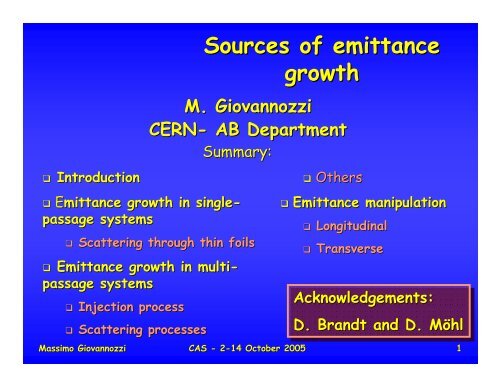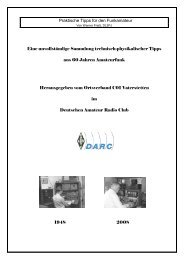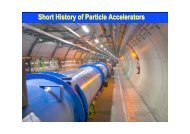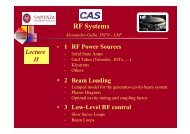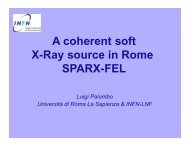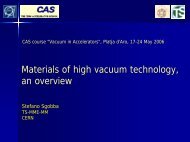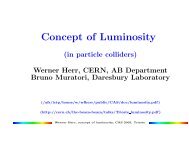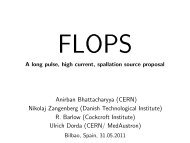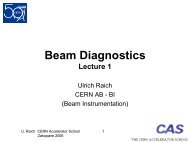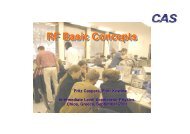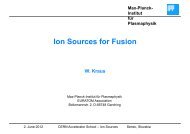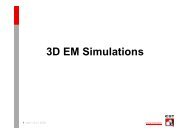2 - CERN Accelerator School
2 - CERN Accelerator School
2 - CERN Accelerator School
Create successful ePaper yourself
Turn your PDF publications into a flip-book with our unique Google optimized e-Paper software.
Introduction<br />
Emittance mittance growth in single-<br />
passage systems<br />
Sources of emittance<br />
growth<br />
M. Giovannozzi<br />
<strong>CERN</strong>- <strong>CERN</strong> AB Department<br />
Summary:<br />
Scattering through thin foils<br />
Emittance growth in multi-<br />
passage systems<br />
Injection process<br />
Scattering processes<br />
Others<br />
Emittance manipulation<br />
Longitudinal<br />
Transverse<br />
Acknowledgements:<br />
D. Brandt and D. Möhl<br />
hl<br />
Massimo Giovannozzi CAS - 2-14 14 October 2005 1
Introduction - I<br />
The starting point is the well-known well known Hill’s Hill s<br />
equation<br />
x ″ (s) + K(s)<br />
x(s)<br />
=<br />
Such an equation has an invariant (the so-<br />
called Courant-Snyder Courant Snyder invariant)<br />
2<br />
A = γ x + 2α x x′<br />
+ β x′<br />
Parenthetically: in in a bending-free bending bending-free free region<br />
the following dispersion invariant exists<br />
2<br />
A = γ<br />
D + 2α D D′<br />
+ β D′<br />
Massimo Giovannozzi CAS - 2-14 14 October 2005 2<br />
2<br />
2<br />
0
Introduction - II<br />
In the case of a beam, i.e. an ensemble of<br />
particles:<br />
Emittance: Emittance:<br />
value of the Courant-Snyder<br />
Courant Snyder<br />
invariant corresponding to a given fraction of<br />
particles.<br />
Example: rms emittance for Gaussian beams.<br />
Why emittance can grow?<br />
Hill equation is linear -> > in the presence of<br />
nonlinear conserved.<br />
effects emittance is no more<br />
Massimo Giovannozzi CAS - 2-14 14 October 2005 3
Introduction - III<br />
Why emittance growth is an issue?<br />
Machine performance is reduced, e.g. in the<br />
case of a collider the luminosity (i.e. the rate<br />
of collisions per unit time) is reduced.<br />
It can lead to beam losses.<br />
Massimo Giovannozzi CAS - 2-14 14 October 2005 4
Introduction - IV<br />
Filamentation is one of the key concepts for<br />
computing emittance growth<br />
Due to the presence of nonlinear imperfections,<br />
the rotation frequency in phase space is amplitude-<br />
dependent.<br />
After a certain time the initial beam distribution is<br />
smeared out to fill a phase space ellipse.<br />
Massimo Giovannozzi CAS - 2-14 14 October 2005 5
Typical situation:<br />
Incident<br />
beam<br />
Scattering through thin foil - I<br />
Vacuum window between the transfer line and a target (in<br />
case of fixed target physics)<br />
Vacuum window to separate standard vacuum in transfer line<br />
from high vacuum in circular machine<br />
Emerging<br />
beam<br />
The beam receives an<br />
angular kick<br />
Massimo Giovannozzi CAS - 2-14 14 October 2005 6
x<br />
p<br />
i<br />
xi<br />
Multiple Coulomb scattering<br />
due to beam-matter<br />
beam matter<br />
interaction is described by<br />
means of the rms<br />
scattering angle:<br />
14 MeV / c L<br />
θ = q 1 +<br />
rms<br />
p<br />
pβ<br />
L<br />
Downstream of the foil the<br />
transformed coordinates<br />
are given by<br />
→<br />
→<br />
x<br />
i<br />
p<br />
xi<br />
=<br />
+<br />
A<br />
p<br />
io<br />
Δ<br />
sin( ψ<br />
p<br />
=<br />
A<br />
i<br />
io<br />
)<br />
Scattering through thin foil - II<br />
rad<br />
cos( ψ<br />
( ε )<br />
i<br />
corr<br />
) + β θ<br />
Normalised coordinate<br />
= α x + β x′<br />
Massimo Giovannozzi CAS - 2-14 14 October 2005 7<br />
p x<br />
α = 0 at the<br />
location of the foil
By assuming that:<br />
Scattering through thin foil -<br />
III<br />
Scattering angle and betatronic phase are uncorrelated<br />
Averaging of the phase, i.e. assuming filamentation in the<br />
transfer line or the subsequent machine<br />
2<br />
i<br />
2<br />
i<br />
2<br />
xi<br />
Therefore the final result is<br />
Taking into account the statistical definition of emittance<br />
π<br />
ε rms ( θ<br />
2<br />
= Δ<br />
Massimo Giovannozzi CAS - 2-14 14 October 2005 8<br />
rms<br />
2<br />
)<br />
2<br />
i0<br />
A = x + p = A + β θ<br />
2<br />
x<br />
2<br />
x0<br />
2σ =<br />
2σ<br />
+ β θ rms<br />
2<br />
β<br />
2<br />
2<br />
2<br />
i
Scattering through thin foil -<br />
IV<br />
Few remarks<br />
A special case with α = 0 at the location of the<br />
thin foil is discussed -> > it can be generalised.<br />
The correct way of treating this problem is (see<br />
next slides):<br />
Compute all three second-order second order moments of the beam<br />
distribution downstream of the foil<br />
Evaluate the new optical parameters and emittance using<br />
the statistical definition<br />
The emittance function!<br />
growth depends on the beta-<br />
THE SMALLER THE VALUE OF THE BETA- BETA<br />
FUNCTION AT THE LOCATION OF THE FOIL<br />
THE SMALLER THE EMITTANCE GROWTH<br />
Massimo Giovannozzi CAS - 2-14 14 October 2005 9
Scattering through thin foil -<br />
V<br />
Correct computation (always for α=0): =0):<br />
x<br />
=<br />
x′<br />
=<br />
−<br />
A<br />
o<br />
A<br />
o<br />
β<br />
o<br />
1/<br />
β<br />
o<br />
By squaring and averaging over the beam distribution<br />
Using the relation<br />
cos( ψ )<br />
o<br />
sin( ψ ) + θ = − A<br />
o 1<br />
2<br />
2 < A0<br />
><br />
< x > =<br />
2<br />
′ 2 < A > 0<br />
< x > =<br />
2β<br />
2<br />
0<br />
β<br />
0<br />
1/<br />
β<br />
1<br />
cos( ψ )<br />
1<br />
sin( ψ<br />
1<br />
Massimo Giovannozzi CAS - 2-14 14 October 2005 10<br />
+<br />
ε rms =<br />
π<br />
θ<br />
=<br />
2<br />
rms<br />
=<br />
A<br />
1<br />
1<br />
β<br />
1<br />
< A2<br />
><br />
2<br />
1<br />
β<br />
1<br />
< A 2 > 1 =<br />
2β<br />
2<br />
A<br />
2<br />
)
The solution of the system is<br />
Scattering through thin foil -<br />
VI<br />
This can be solved exactly, or by assuming that the<br />
relative emittance growth is small, then<br />
emittance growth is now only half<br />
π<br />
Δε<br />
rms = θ 2β<br />
rms 0<br />
4<br />
1, β1<br />
Twiss<br />
⎡<br />
⎤<br />
⎢ π θ 2 ⎥<br />
β = β ⎢1−<br />
rms<br />
1 0<br />
⎥<br />
⎢ 4 ε ⎥<br />
⎢⎣<br />
rms ⎥⎦<br />
NB: NB: the the emittance<br />
growth is now only half<br />
of of the the previous estimate!<br />
Downstream of of the the foil foil the the transfer line<br />
line<br />
should be be matched using the the new new Twiss<br />
parameters α1, α1, β1<br />
Massimo Giovannozzi CAS - 2-14 14 October 2005 11<br />
A<br />
β1<br />
β<br />
0<br />
2<br />
1<br />
2<br />
=<br />
−<br />
A<br />
2<br />
0<br />
A<br />
A<br />
A<br />
2<br />
0<br />
2<br />
0<br />
2<br />
1<br />
2<br />
=<br />
2β<br />
0<br />
θ<br />
2<br />
rms
70<br />
50<br />
30<br />
10<br />
-10<br />
β H<br />
Stripper location<br />
D V<br />
Example: ion stripping for LHC<br />
lead beam between PS and SPS<br />
β V<br />
D H<br />
0 50 100 150 200 250 300<br />
Courtesy M. M. Martini - <strong>CERN</strong><br />
Pb 54+ -> > Pb 82+<br />
A low-beta low beta<br />
insertion is<br />
designed (beta<br />
reduced by a<br />
factor of 5)<br />
Stripping foil,<br />
0.8 mm thick<br />
Al, is located in<br />
the low-beta low beta<br />
insertion<br />
Massimo Giovannozzi CAS - 2-14 14 October 2005 12
Exercises…<br />
Exercises<br />
Compute the Twiss parameters and emittance<br />
growth for a THICK foil<br />
Compute the Twiss parameters and emittance<br />
growth for a THICK foil in a quadrupolar field<br />
Massimo Giovannozzi CAS - 2-14 14 October 2005 13
Two sources of errors:<br />
Injection process - I<br />
Steering errors.<br />
Optics errors (Twiss ( Twiss parameters and dispersion).<br />
In case the incoming beam has an energy<br />
error, then the next effect will be a<br />
combination of the two.<br />
In all cases filamentation, filamentation,<br />
i.e. nonlinear<br />
imperfection in the ring, is the source of<br />
emittance growth.<br />
Massimo Giovannozzi CAS - 2-14 14 October 2005 14
Steering errors:<br />
Injection process - II<br />
Injection conditions, i.e. position and angle, do not<br />
match position and angle of the closed orbit.<br />
Consequences:<br />
The beam performs betatron oscillations around the<br />
closed orbit. The emittance grows due to the<br />
filamentation<br />
Solution:<br />
Change the injection conditions, either by steering<br />
in the transfer line or using the septum and the<br />
kicker.<br />
In practice, slow drifts of settings may require<br />
regular tuning. In this case a damper (see course<br />
on feedback systems) is the best solution.<br />
Massimo Giovannozzi CAS - 2-14 14 October 2005 15
Analysis in normalised phase<br />
space (i ( stands for injection<br />
m for machine):<br />
x<br />
p<br />
m<br />
m<br />
=<br />
=<br />
r<br />
r<br />
i<br />
i<br />
cosψ<br />
sinψ<br />
Squaring and averaging gives<br />
<<br />
<<br />
r<br />
r<br />
2<br />
m<br />
2<br />
m<br />
><br />
><br />
=<br />
=<br />
<<br />
<<br />
After filamentation<br />
2<br />
x<br />
r<br />
2<br />
i<br />
i<br />
2<br />
m<br />
2<br />
i<br />
+ Δr<br />
cosψ<br />
Injection process - III<br />
+ Δr<br />
cosψ<br />
+<br />
p<br />
2<br />
m<br />
> + Δr<br />
< x > = 1 < rm<br />
> = 1 < ri<br />
> + 1 Δr<br />
2<br />
2<br />
2<br />
><br />
2<br />
2<br />
Massimo Giovannozzi CAS - 2-14 14 October 2005 16<br />
σ<br />
2<br />
= σ<br />
2<br />
i<br />
+<br />
1 2<br />
Δr<br />
2
Example of beam<br />
distribution<br />
generated by<br />
steering errors<br />
and filamentation.<br />
filamentation<br />
The beam core is<br />
displaced -> > large<br />
effect on<br />
emittance growth<br />
Injection process - IV<br />
Massimo Giovannozzi CAS - 2-14 14 October 2005 17
Dispersion mismatch:<br />
analysis is similar to<br />
that for steering errors.<br />
In this case<br />
Δr<br />
2<br />
⎡<br />
= ⎢ΔD<br />
⎣<br />
2<br />
+<br />
1<br />
2<br />
( β ΔD′<br />
+ α ΔD)<br />
The final result is<br />
ε<br />
after fil.<br />
rms<br />
= ε<br />
rms<br />
Injection process - V<br />
2<br />
⎤ ⎛ σ<br />
⎥<br />
⎜<br />
⎦<br />
⎜<br />
⎝ p<br />
p<br />
Massimo Giovannozzi CAS - 2-14 14 October 2005 18<br />
⎞<br />
⎟<br />
⎠<br />
2<br />
⎧<br />
2<br />
⎪ 1 [ ( ) ]<br />
2<br />
2 ⎛ σ p ⎞<br />
⎨1<br />
+ ΔD<br />
+ β ΔD′<br />
+ α ΔD<br />
⎜ ⎟<br />
⎜ ⎟<br />
/ σ 0<br />
⎪⎩<br />
2<br />
⎝ p ⎠<br />
2<br />
⎫<br />
⎪<br />
⎬<br />
⎪⎭
Optics errors:<br />
Optical parameters (Twiss ( Twiss and<br />
dispersion) of the transfer line<br />
at the injection point are<br />
different from those of the ring<br />
Consequences:<br />
The beam performs quadrupolar<br />
oscillations (size changes on a<br />
turn-by turn by-turn turn basis). The<br />
emittance grows due to the<br />
filamentation<br />
Solution:<br />
Tune transfer line to match<br />
optics of the ring<br />
Injection process - VI<br />
Massimo Giovannozzi CAS - 2-14 14 October 2005 19<br />
x’<br />
Ring ellipse<br />
Transfer<br />
line ellipse<br />
x
Injection process - VII<br />
In normalised phase space (that of the ring) the<br />
injected beam will fill an ellipse due to the<br />
mismatch of the optics…<br />
optics<br />
Massimo Giovannozzi CAS - 2-14 14 October 2005 20
ε<br />
after fil.<br />
rms<br />
=<br />
ε<br />
rms<br />
⎛<br />
⎜<br />
⎝<br />
l<br />
i<br />
Injection process - VIII<br />
Given the initial condition of the beam end of the transfer<br />
line<br />
x = A b / a sinψ<br />
, p = A a / b cosψ<br />
b / a<br />
2<br />
<<br />
2 2<br />
ri >= < Ai<br />
+ a / b<br />
⎞<br />
⎟<br />
⎠<br />
i<br />
By squaring and averaging over the particles’ particles distribution<br />
><br />
Massimo Giovannozzi CAS - 2-14 14 October 2005 21<br />
l<br />
i<br />
( b / a + a / b)<br />
The emittance after filamentation is given by<br />
ε<br />
F<br />
2<br />
after fil.<br />
rms<br />
=<br />
=<br />
ε<br />
rms<br />
1<br />
⎛<br />
⎜ β l<br />
2 ⎜ β m ⎝<br />
+<br />
F<br />
β m<br />
β<br />
l<br />
i<br />
⎛ α<br />
+<br />
⎜<br />
⎝ β<br />
m<br />
m<br />
αl<br />
⎞<br />
−<br />
⎟<br />
β l ⎠<br />
2<br />
β<br />
m<br />
⎞<br />
β<br />
⎟<br />
l ⎟<br />
⎠
Scattering processes - I<br />
Two main categories considered:<br />
Scattering on residual gas -> > similar to scattering<br />
on a thin foil (the gas replaces the foil…) foil<br />
Δε<br />
kσ<br />
=<br />
2<br />
2 2 14 MeV / c β pc<br />
t<br />
k q p<br />
β<br />
2 pβ<br />
⎟<br />
p Lrad<br />
⎟<br />
⎛<br />
⎞<br />
⎜<br />
⎝<br />
⎠<br />
π<br />
NB: βpct ct represents the<br />
scatterer length until time t<br />
NB: β p ct represents the<br />
where<br />
average beta<br />
Intra-beam Intra beam scattering, i.e. Coulomb scattering<br />
between charged particles in the beam.<br />
Massimo Giovannozzi CAS - 2-14 14 October 2005 22<br />
β<br />
This is is why good<br />
vacuum is is necessary!
Intra-beam Intra beam scattering<br />
Multiple (small angle)<br />
Coulomb scattering<br />
between particles.<br />
charged<br />
Single scattering<br />
events lead to<br />
Touscheck effect.<br />
All three degrees of<br />
freedom are affected.<br />
Scattering processes - II<br />
Massimo Giovannozzi CAS - 2-14 14 October 2005 23
Scattering processes - III<br />
How to compute IBS?<br />
Transform momenta of colliding particles into their centre<br />
of mass system.<br />
Rutherford cross-section cross section is used to compute change of<br />
momenta. momenta<br />
Transform the new momenta back to the laboratory<br />
system.<br />
Calculate the change of the emittances due to the change<br />
of momenta at the given location of the collision.<br />
1. For each scattering event compute average over all<br />
possible scattering angles (impact parameters from the<br />
size of the nucleus to the beam radius).<br />
2. Take the average over momenta and transverse position of<br />
the particles at the given location on the ring<br />
circumference (assuming Gaussian distribution in all phase<br />
space planes.<br />
3. Compute the average around the circumference, including<br />
lattice functions, to determine the change per turn.<br />
Massimo Giovannozzi CAS - 2-14 14 October 2005 24
Scattering processes - IV<br />
Features of IBS<br />
For constant lattice functions and below<br />
transition energy, the sum of the three<br />
emittances is constant.<br />
Above transition the sum of the emittances<br />
always grows.<br />
In any strong focusing lattice the sum of the<br />
emittances always grows.<br />
Even though the sum grows from the<br />
theoretical point of view emittance reduction<br />
in one plane predicted by simulations, but<br />
were never observed.<br />
Massimo Giovannozzi CAS - 2-14 14 October 2005 25
Scattering processes - V<br />
Scaling laws of IBS<br />
Accurate computations can be performed only with<br />
numerical tools.<br />
However, scaling laws can be derived.<br />
Assuming<br />
1 1<br />
=<br />
Then<br />
1/<br />
τ0<br />
=<br />
( 4/<br />
2<br />
π<br />
*<br />
x<br />
*<br />
y<br />
τ<br />
2<br />
2<br />
2⎛q<br />
⎞<br />
Nbr0<br />
⎜<br />
A ⎟<br />
⎝ ⎠<br />
) γ ε ε ε / E<br />
*<br />
l<br />
x,<br />
y,<br />
l<br />
0<br />
τ<br />
∝<br />
0<br />
F x,<br />
y,<br />
l<br />
2 ⎛q<br />
⎞<br />
Nb<br />
⎜<br />
A ⎟<br />
⎝ ⎠<br />
γ ε ε ε<br />
*<br />
x<br />
Massimo Giovannozzi CAS - 2-14 14 October 2005 26<br />
*<br />
y<br />
2<br />
*<br />
l<br />
Strong charge<br />
dependence on<br />
on<br />
ε x,y,l* x,y,l*<br />
are x,y,l* are<br />
emittances<br />
normalised<br />
N b of b of particles/bunch<br />
r 0 classical 0 classical proton radius
Diffusive phenomena:<br />
Others<br />
Resonance crossings<br />
Ripple in the power converters<br />
Collective effects<br />
Space charge (soft part of Coulomb interactions<br />
between charged particles in the beam) -> > covered<br />
by a specific course. course<br />
Beam-beam<br />
Beam beam -> > covered by a specific course. course<br />
Instabilities -> > covered by a specific course.<br />
course<br />
Massimo Giovannozzi CAS - 2-14 14 October 2005 27
Emittance manipulation<br />
Emittance is (hopefully) conserved…<br />
conserved<br />
Sometimes, it is necessary to manipulate the<br />
beam so to reduce its emittance.<br />
emittance<br />
Standard techniques: electron cooling, stochastic<br />
cooling.<br />
Less standard techniques: longitudinal or transverse<br />
emittance splitting.<br />
Massimo Giovannozzi CAS - 2-14 14 October 2005 28
PS ejection:<br />
72 bunches<br />
in 1 turn<br />
Acceleration<br />
to 25 GeV<br />
PS injection:<br />
2+4 bunches<br />
in 2 batches<br />
320 ns beam gap<br />
Quadruple splitting<br />
at 25 GeV<br />
Triple splitting<br />
at 1.4 GeV<br />
Longitudinal manipulation:<br />
LHC beam in PS machine - I<br />
Empty<br />
bucket<br />
72 bunches<br />
on h=84<br />
18 bunches<br />
on h=21<br />
6 bunches<br />
on h=7<br />
0.35 eVs (bunch)<br />
1.1 × 10 11 ppb<br />
1 eVs (bunch)<br />
4.4 × 10 11 ppb<br />
1.4 eVs (bunch)<br />
13.2 × 10 11 ppb<br />
40 %<br />
Blow-up<br />
(pessimistic)<br />
115 %<br />
Blow-up<br />
(voluntary)<br />
Courtesy R. R. Garoby - <strong>CERN</strong><br />
Massimo Giovannozzi CAS - 2-14 14 October 2005 29
Courtesy R. R. Garoby - <strong>CERN</strong><br />
Longitudinal manipulation:<br />
LHC beam in PS machine -<br />
II<br />
Measurement results<br />
obtained at at the <strong>CERN</strong><br />
Proton Synchrotron<br />
Massimo Giovannozzi CAS - 2-14 14 October 2005 30
Transverse manipulation:<br />
novel multi-turn multi turn extraction –<br />
I<br />
The main ingredients of the novel extraction:<br />
The beam splitting is not performed using a<br />
mechanical device, thus avoiding losses. Indeed, the<br />
beam is separated in the transverse phase space<br />
using<br />
Nonlinear magnetic elements (sextupoles ad<br />
octupoles) to create stable islands. islands<br />
Slow (adiabatic ( adiabatic) ) tune-variation tune variation to cross an<br />
appropriate resonance.<br />
NB: third-order third third-order order extraction is is based on<br />
separatrices (see O. Brüning Br Brüning ning lecture)<br />
Massimo Giovannozzi CAS - 2-14 14 October 2005 31
1<br />
X’<br />
(a)<br />
-1<br />
-1 X<br />
1<br />
Four islands<br />
require<br />
tune = 0.25<br />
Transverse manipulation: novel<br />
multi-turn multi turn extraction – II<br />
Left: initial phase<br />
space topology. No<br />
islands.<br />
Right: intermediate<br />
phase space topology.<br />
Islands are created<br />
near the centre.<br />
1<br />
X’<br />
-1<br />
-1 X<br />
1<br />
-1<br />
-1 X<br />
1<br />
Massimo Giovannozzi CAS - 2-14 14 October 2005 32<br />
(c)<br />
1<br />
X’<br />
(b)<br />
Bottom: final phase<br />
space topology.<br />
Islands are separated<br />
to allow extraction.
Tune variation<br />
Phase space<br />
portrait<br />
Transverse manipulation:<br />
novel multi-turn multi turn extraction –<br />
III<br />
Simulation<br />
parameters:<br />
Hénon non-like like<br />
map (i.e. 2D<br />
polynomial –<br />
degree 3 -<br />
mapping)<br />
representing<br />
a FODO cell<br />
with<br />
sextupole and<br />
octupole<br />
Massimo Giovannozzi CAS - 2-14 14 October 2005 33
A movie to show the evolution of<br />
beam distribution<br />
A series of<br />
horizontal beam<br />
profiles have been<br />
taken during the<br />
capture process.<br />
Measurement results<br />
obtained at the <strong>CERN</strong><br />
Proton Synchrotron<br />
Massimo Giovannozzi CAS - 2-14 14 October 2005 34
Some references<br />
D. Edwards, M. Syphers: Syphers:<br />
An introduction to the<br />
physics of high energy accelerators, J. Wiley & Sons,<br />
NY 1993.<br />
P. Bryant, K. Johnsen: Johnsen:<br />
The principles of circular<br />
accelerators and storage rings, Cambridge University<br />
press, 1993.<br />
P. Bryant: Beam transfer lines, <strong>CERN</strong> yellow rep. 94- 94<br />
10 (CAS, Jyvaskyla, Jyvaskyla,<br />
Finland , 1992).<br />
J. Buon: Buon:<br />
Beam phase space and emittance, emittance,<br />
<strong>CERN</strong><br />
yellow rep. 91-04 91 04 (CAS, Julich, Julich,<br />
Germany, 1990).<br />
A. Piwinski: Piwinski:<br />
Intra-beam Intra beam scattering, <strong>CERN</strong> yellow rep.<br />
85-19 85 19 (CAS, Gif-sur Gif sur-Yvette, Yvette, France 1984).<br />
A. H. Sorensen: Sorensen:<br />
Introduction to intra-beam<br />
intra beam<br />
scattering, <strong>CERN</strong> yellow rep. 87-10 87 10 (CAS, Aarhus, Aarhus,<br />
Denmark 1986).<br />
Massimo Giovannozzi CAS - 2-14 14 October 2005 35


